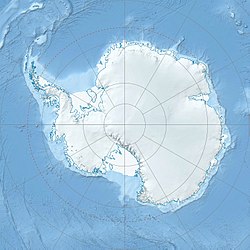Top Qs
Timeline
Chat
Perspective
Murray Monolith
Monolith of Antarctica From Wikipedia, the free encyclopedia
Remove ads
Murray Monolith is a detached part of Torlyn Mountain in Mac.Robertson Land, Antarctica. It is a steep massif of metasedimentary gneiss and granitic origin, with the adjacent coastline consisting of 40 m high ice cliffs. The monolith is dome-shaped with steep sides, rising to a seaward summit of 339 m and an inland summit of 363 m at Torlyn Mountain.[1]


Remove ads
Discovery and naming
It was discovered during the British Australian New Zealand Antarctic Research Expedition (BANZARE), led by Douglas Mawson, 1929–1931, and named after Sir George Murray, Chief Justice of South Australia Chancellor of the University of Adelaide and a patron of the expedition.[2]
Antarctic Specially Protected Area and Important Bird Area
As one of the very few pieces of exposed rock on the East Antarctic coast, together with the Scullin Monolith 6 km to the west, it holds the greatest concentration of seabird breeding colonies in East Antarctica, including 160,000 pairs of Antarctic petrels, and 70,000 pairs of Adelie penguins.[3] Both monoliths are protected under the Antarctic Treaty System as Antarctic Specially Protected Area (ASPA) No.164.[3] Coincident in coverage with ASPA 164, the two monoliths have also been designated an Important Bird Area (IBA) by BirdLife International because of the significant seabird colonies present.[1]
Remove ads
Further reading
- Ute Christina Herzfeld, Atlas of Antarctica: Topographic Maps from Geostatistical Analysis of Satellite Radar Altimeter Data, P 86
See also
References
External links
Wikiwand - on
Seamless Wikipedia browsing. On steroids.
Remove ads

